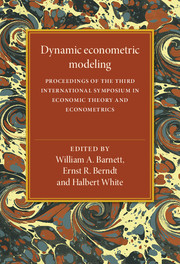 Dynamic Econometric Modeling
Dynamic Econometric Modeling Book contents
- Frontmatter
- Contents
- Editors' introduction
- List of contributors
- Part I Dynamic structural modeling
- 1 Efficient instrumental variables estimation of systems of implicit heterogeneous nonlinear dynamic equations with nonspherical errors
- 2 Envelope consistent functional separability
- 3 Flexible functional forms for profit functions and global curvature conditions
- 4 Likelihood inference in the nonlinear regression model with explosive linear dynamics
- 5 Exact inference in models with autoregressive conditional heteroscedasticity
- 6 Control of a linear regression process with unknown parameters
- 7 Some tests of nonparametric regression models
- Part II Linear time series modeling
- Part III Chaotic attractor modeling
- Part IV Applications
4 - Likelihood inference in the nonlinear regression model with explosive linear dynamics
Published online by Cambridge University Press: 03 May 2010
- Frontmatter
- Contents
- Editors' introduction
- List of contributors
- Part I Dynamic structural modeling
- 1 Efficient instrumental variables estimation of systems of implicit heterogeneous nonlinear dynamic equations with nonspherical errors
- 2 Envelope consistent functional separability
- 3 Flexible functional forms for profit functions and global curvature conditions
- 4 Likelihood inference in the nonlinear regression model with explosive linear dynamics
- 5 Exact inference in models with autoregressive conditional heteroscedasticity
- 6 Control of a linear regression process with unknown parameters
- 7 Some tests of nonparametric regression models
- Part II Linear time series modeling
- Part III Chaotic attractor modeling
- Part IV Applications
Summary
Introduction
The rapid growth of dynamic economic theory has contributed to the increasing use of nonlinear regression in applied time series econometrics. The interest in tractable theories of estimation and hypothesis testing for such nonlinear time series models has grown accordingly. The body of theory relevant to parametric structures that has emerged over the past few years is quite elegant and virtually complete in some respects.
Standard limiting results, such as the asymptotic normality of an estimator or the chi–squared distribution of a test statistic for testing restrictions, rely on trade–offs between moment assumptions and assumptions regarding the dependence of the stochastic process being considered. In particular, most current theories that allow deviations from stationarity assumptions rely on dependence concepts stronger than the ergodic property appropriate for stationary structures. Stationarity and/or such restrictions on the dependence properties of the involved stochastic processes are notoriously hard to verify in nonlinear models.
The problem addressed in this chapter rests on a potentially more serious consideration than difficulties in the verification of assumptions. Recent investigations of the stochastic properties of decision variables arising from various classes of dynamic models reveal that the stochastic processes describing such decision variables can indeed fail to have the ergodic property. Theoretical results obtained by Chamberlain and Wilson (1984) for a wide class of intertemporal consumption plans indicate this. Empirical examples illustrating explosiveness in models of consumption include the work of Hall (1978) and Daly and Hadjimatheou (1981).
- Type
- Chapter
- Information
- Dynamic Econometric ModelingProceedings of the Third International Symposium in Economic Theory and Econometrics, pp. 53 - 72Publisher: Cambridge University PressPrint publication year: 1988
- 1
- Cited by
